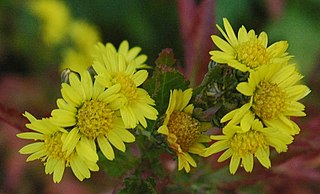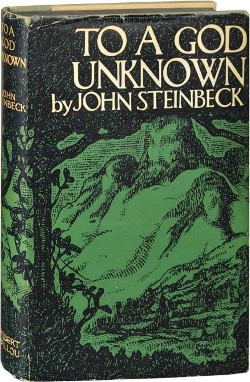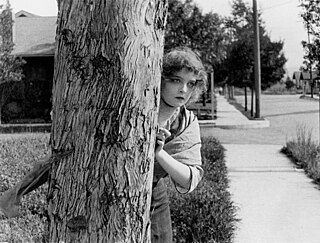
John Ernst Steinbeck was an American writer. He won the 1962 Nobel Prize in Literature "for his realistic and imaginative writings, combining as they do sympathetic humor and keen social perception". He has been called "a giant of American letters."

The Grapes of Wrath is an American realist novel written by John Steinbeck and published in 1939. The book won the National Book Award and Pulitzer Prize for fiction, and it was cited prominently when Steinbeck was awarded the Nobel Prize in Literature in 1962.

Of Mice and Men is a 1937 novella written by American author John Steinbeck. It narrates the experiences of George Milton and Lennie Small, two displaced migrant ranch workers, who move from place to place in California in search of new job opportunities during the Great Depression in the United States.

Of Mice and Men is a 1939 American drama film based on the 1937 play of the same name, which itself was based on the novella of the same name by author John Steinbeck. The film stars Burgess Meredith, Betty Field, and Lon Chaney Jr., and features Charles Bickford, Roman Bohnen, Bob Steele, and Noah Beery Jr. The film tells the story of two men, George and his intellectually disabled partner Lennie, trying to survive during the dustbowl of the 1930s and pursuing a dream of owning their own ranch instead of always working for others. Starring in the lead roles were relative Hollywood newcomer Burgess Meredith as George and veteran actor Lon Chaney Jr. as Lennie. Chaney had appeared in more than 50 films by that point in his career, but Of Mice and Men was his first major role. Betty Field's role as Mae was her breakthrough role in film.

East of Eden is a novel by American author and Nobel Prize winner John Steinbeck, published in September 1952. Many regard the work as Steinbeck's most ambitious novel, and Steinbeck himself considered it his magnum opus. Steinbeck said of East of Eden: "It has everything in it I have been able to learn about my craft or profession in all these years," and later said: "I think everything else I have written has been, in a sense, practice for this." Steinbeck originally addressed the novel to his young sons, Thom and John. Steinbeck wanted to describe the Salinas Valley for them in detail: the sights, sounds, smells and colors.

Chrysanthemums, sometimes called mums or chrysanths, are flowering plants of the genus Chrysanthemum in the family Asteraceae. They are native to East Asia and northeastern Europe. Most species originate from East Asia and the center of diversity is in China. Countless horticultural varieties and cultivars exist.

To a God Unknown is a novel by John Steinbeck, first published in 1933. The book was Steinbeck's second novel. Steinbeck found To a God Unknown extremely difficult to write; taking him roughly five years to complete, the novel proved more time-consuming than either East of Eden or The Grapes of Wrath, Steinbeck's longest novels.

Floriography is a means of cryptological communication through the use or arrangement of flowers. Meaning has been attributed to flowers for thousands of years, and some form of floriography has been practiced in traditional cultures throughout Europe, Asia, and Africa.

The Pastures of Heaven is a short story cycle by John Steinbeck published by Brewer, Warren and Putnam in 1932.

The Red Pony is an episodic novella written by American writer John Steinbeck in 1933. The first three chapters were published in magazines from 1933 to 1936. The full book was published in 1937 by Covici Friede. The stories in the book are tales of a boy named Jody Tiflin. The book has four stories about Jody and his life on his father's California ranch. Other main characters include Carl Tiflin – Jody's father; Billy Buck – an expert in horses and a working hand on the ranch; Mrs. Tiflin – Jody's mother; Jody's grandfather – Mrs. Tiflin's father, who has a history of crossing the Oregon Trail, and enjoys telling stories about his experiences; and Gitano – an old man who wishes to die at the Tiflin ranch. Along with these stories, there is a short story at the end of the book titled "Junius Maltby". However, this last story is omitted in the edition published by Penguin Books.

The Wayward Bus is a novel by American author John Steinbeck, published in 1947. The novel's epigraph is a passage from the 15th-century English play Everyman, with its archaic English intact; the quotation refers to the transitory nature of humanity. Although considered one of Steinbeck's weaker novels at the time of its original publication, The Wayward Bus was financially more successful than any of his previous works.

Jubilee (1966) is a historical novel written by Margaret Walker, which focuses on the story of a biracial slave during the American Civil War. It is set in Georgia and later in various parts of Alabama in the mid-19th century before, during, and after the Civil War.
"The Storm" is a short story written by the American writer Kate Chopin in 1898. The story takes place during the 19th century in the South of the United States, where storms are frequent and dangerous. It did not appear in print in Chopin's lifetime, but it was published in The Complete Works of Kate Chopin in 1969. This story is the sequel to Chopin's "At the 'Cadian Ball".

The Long Valley is a collection of short fiction by John Steinbeck. Most of the stories appeared originally in literary periodicals, and were first collected by Viking Press in 1938.

The Mothering Heart is a 1913 American short drama film directed by D. W. Griffith. A print of the film survives in the film archive of the Museum of Modern Art.
"The Sprig of Thyme", "The Seeds of Love", "Maiden’s Lament", "Garners Gay", "Let No Man Steal Your Thyme" or "Rue" is a traditional British and Irish folk ballad that uses botanical and other symbolism to warn young people of the dangers in taking false lovers. The song was first documented in 1689 and the many variants go by a large number of titles.

Within Catholicism, a miracle of the roses is a miracle in which roses manifest an activity of God or of a saint. Such a miracle is presented in various hagiographies and legends in different forms, and it occurs in connection with diverse individuals such as Saints Elizabeth of Hungary (1207–1231), Elizabeth of Portugal (1271–1336), Saint Dorothy, a 4th-century virgin martyr at Caesarea in Cappadocia, and Our Lady of Guadalupe.

"A Flowering Tree" is a short story written by A. K. Ramanujan in his 1997 book A Flowering Tree and Other Oral Tales from India. In actuality, it is a Karnataka folklore told by women which was translated by A. K. Ramanujan from Kannada to English. The story was collected in several versions in the Karnataka region over the span of twenty years by Ramanujan and his fellow folklorists. It is a woman-centred tale and attempts to establish a sisterhood between women and nature. This has been regularly done by many feminist writers.
East of Eden is a 1981 American television miniseries based on John Steinbeck's 1952 novel of the same name. It aired in three parts on ABC from February 8–11, 1981. It was directed by Harvey Hart from a teleplay by Richard Shapiro, and starred Timothy Bottoms, Jane Seymour, Bruce Boxleitner, Soon Tek-Oh, Sam Bottoms, Hart Bochner, Karen Allen and Lloyd Bridges. It ran for roughly 382 minutes.
“The White Quail” is a work of short fiction by John Steinbeck originally appearing in The North American Review, March 1935. The story was first collected in The Long Valley (1938) published by Viking Press.















